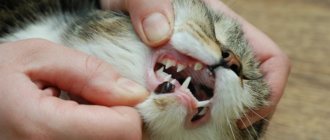Outside of illness, the cat scratches its ears when there is wax, shakes its head due to water getting in while bathing. If the itching is constant, and the animal scratches the skin until it bleeds, then the cause is often infection with ticks (otodectosis), fleas, inflammation of the skin (dermatitis due to allergies, infections). With a purulent process inside the ear (otitis), itching is accompanied by discharge with an unpleasant odor.
Skin irritation with the appearance of dandruff is explained by seborrhea, and swelling with a bluish color is due to shock and accumulation of blood (hematoma). When cats have ringworm, they scratch their ears and the hair on the affected area falls out. You can only try to rinse the ear canals with saline solution on your own to remove the wax plug.
In all other cases, they contact the veterinarian, he takes a scraping and sends the discharge for culture. Treatment includes drops with an antibacterial or antiparasitic effect (for example, Amitrazine), and the doctor also gives recommendations on nutrition and cleansing of the ears.
If a cat scratches its ears, is this always a sign of illness?
If a domestic cat scratches its ears, then outside of diseases it is usually associated with insufficient ear hygiene. Normally, cats independently cleanse the ear canal of wax and dirt during chewing. Some breeds (for example, Scottish Fold, Scottish Fold) have peculiarities in the structure of the ear; they need the owner’s help in cleansing the skin of wax.
If hygiene procedures are not carried out in time, a sulfur plug appears. It makes the cat feel uncomfortable, and he tries to get rid of the accumulation of earwax. However, it can be located deep and not visible upon examination. Because of this, the cat shakes his head, but the ears are clean on the outside.
With regular but aggressive cleaning of the ears and injury to the skin, wax begins to be produced in increased quantities, so all movements must be careful and not cause protest in the animal. If you are unable to cleanse yourself, you should seek help from a veterinarian.
Similar symptoms occur due to water getting into the ear canal when swimming. The cat begins to shake its head and rub its ears with its paws. Therefore, owners need to use a cap or ear plugs, and after the water procedure, carefully blot off excess water with cotton pads.
Diagnostic methods
To determine why your kitten is scratching its ear excessively, you need to contact your veterinarian.
You can spot ear mite infestations on your own. To do this, you need to wipe the auricle with a cotton swab, transfer the resulting material to a black cloth, and examine it through a magnifying glass.
White parasites on a black background will be clearly visible.
Other pathologies are identified in a veterinary clinic. The doctor performs a visual examination. The presence of peeling, brown discharge, and swelling will indicate dermatitis.
The following laboratory tests will help make an accurate diagnosis:
- Bacteriological culture. Often impossible due to lack of necessary equipment.
- Smear. This diagnostic procedure allows you to identify the exact cause of intense itching.
- X-ray.
- Ultrasonography.
Treatment depends on the cause of the disease. Therapy is selected on an individual basis.
A cat scratches its ears: what to do to understand whether it’s time to see a doctor or not
If a cat scratches its ears constantly, then it is necessary to observe and conduct an external examination of the animal to identify the first signs of disease:
- the ears are hot, red or intensely pink;
- discharge of fluid or pus is visible inside the ear;
- there are scratches, scratch marks, bloody or yellow crusts on the surface;
- there was an unpleasant smell from the ears;
- instead of an even layer of hair near the auricle, bald spots appeared;
- the cat makes unnatural movements, as if trying to shake something out of its ear;
- the animal does not allow itself to be stroked on the head and the ear canal examined;
- the cat tries to scratch its ear on any objects;
- appetite has worsened;
- the cat sleeps or lies all the time, activity is lost.
How to recognize the cause
To do this, you need to know the symptoms of ear diseases in your four-legged friends and start monitoring your cat.
Symptoms:
- excessive attention to the ears is a direct signal of illness;
- the cat rubs its head on absolutely every object in the house, and does this almost constantly;
- in the outer ear the skin becomes sticky;
- periodic shaking of the head and tilting it to one side;
- discharge from the ear of absolutely any consistency and color, with an unpleasant odor;
- if you wrap the ear, you can find black spots, accumulations, scratches, sores, wounds, redness;
- the pet is restless, does not play at all, is nervous, growls. Sometimes he even shows aggression.
If a cat scratches its ears until it bleeds, shakes its head: the main reasons
If a cat scratches its ears until it bleeds and shakes its head, then the cause is:
- accumulation of blood due to injury - hematoma;
- inflammation of the outer, middle and inner ear - otitis media;
- infestation with fleas and ticks (otodecosis);
- allergic reaction to food, drugs, pollen;
- fungal infection (lichen);
- impaired sebum secretion - seborrhea;
- entry of a foreign body.
Hematoma (bruise)
When a head injury occurs, a fight with relatives, or compression of the ear, an accumulation of blood occurs - a hematoma. Its appearance is explained by slight injury to the delicate and thin skin of the ears, which have an active blood supply. Therefore, even a small impact is enough to damage blood vessels.
If the surface layer is not damaged, then the blood permeates the tissues, then the cat’s ear hurts and itches, and the damaged area swells and a bluish or purple color appears (bruise). The auricle changes shape, thickens, may sag or even be pressed against the head.
With a hematoma near the ear, the skin becomes hot, and a soft formation of varying sizes can be detected. The cat does not allow us to examine and palpate the ear because of the pain. A characteristic sign is tilting the head towards the affected area and general anxiety. Possible refusal of food and decreased physical activity.
Otitis of various etiologies
When a cat's ears are dirty and itchy, the cause is inflammation - otitis media. It occurs when infected with a bacterial, viral or fungal infection. Allergic and parasitic otitis media may also occur in cats. The provoking factor is hypothermia, water getting into the ear, weakening of the body due to concomitant illness, and fasting.
The development of the disease can be acute. Then the animal:
- local and general temperature increases;
- loss of appetite;
- any touch to the ears causes severe anxiety;
- there is brown or green discharge from the ear canal in the form of crumbs or a liquid, lumpy mass;
- redness of the ears occurs;
- activity is absent or reduced.
With otitis media, the cat meows and dodges stroking, and the itching is so unbearable that he scratches his ears until they bleed. Wounds can also fester, worsening the animal's condition.
If acute inflammation is not detected in time and the full course of treatment is not carried out, then otitis media becomes chronic. Periods of exacerbation alternate with subsiding of symptoms. Advanced disease leads to deafness, paralysis of the facial nerve, and infection in the brain. Extremely severe otitis media causes death.
According to the location of the lesion, otitis media can be external (inflammation of the external auditory canal, part of the auricle), middle (eardrum area) and internal (vestibular apparatus responsible for balance).
Flea infestation
If a cat twitches its ears and constantly scratches them with its paw, becomes restless and loses weight, then this may be due to flea infestation. These parasites can be found in both street and domestic animals. Infection occurs through contact with another cat, or the owner may bring fleas on shoes or clothes. Irritation of the skin of the ears and severe, continuous itching from parasite bites leads to inflammation - flea dermatitis.
This is especially difficult for young and elderly animals. If a kitten continuously scratches its ears and refuses to eat, then serious weakening of the body, weight loss, and anemia (anemia) are possible. Complications include allergic reactions, hair loss, suppuration of scratching wounds, and the addition of infectious diseases due to decreased immunity.
Allergic dermatitis internally
With allergic dermatitis, the cat's ears are red and itchy inside. The cause of allergy development is:
- genetic predisposition;
- incorrectly selected and low-quality food;
- individual intolerance to foods, cosmetics and hygiene products (shampoo, soap);
- contact with household chemicals, plants;
- medications;
- unfavorable environmental conditions;
- chronic bronchial diseases, asthma;
- intestinal dysbiosis;
- worms, fleas, ticks;
- skin diseases.
With allergies, the cat most often scratches its eyes and ears, there is redness of the eyelids and watery eyes, difficulty breathing, sneezing, and coughing. Animals develop rashes, swelling of paws, hair loss, vomiting and diarrhea.
Ringworm (fungal infection of the skin of the ear)
With lichen, the cat scratches its ears until there are “sores” (wounds). It most often develops during infection caused by trichophytosis and microsporia fungi. Risk factors:
- walking outside;
- malnutrition;
- infection with worms;
- drop in immune defense when using potent drugs;
- tumor process
Ringworm near the ear causes:
- severe itching;
- hair loss;
- the appearance of round or oval spots with a clear rim, peeling, vesicles or pustular elements are noticeable in their center;
- inflammatory reaction with redness of the skin;
- the skin of the affected areas becomes discolored.
Similar symptoms are possible with allergic diseases and viral infections, so an accurate diagnosis can only be made after an examination.
Otodectosis is the most common cause of severe itching
Severe itching very often occurs in cats with otodectosis. This disease is also called ear scabies, which is caused by the otodectosis mite. It is not visible when examining the ear because it is extremely small.
Crusts on the ears become a sign of infection; they appear due to an inflammatory reaction to the waste products of the parasite. A tick can get to a cat through direct contact with another infected animal or through the use of a shared object (for example, a bed). There is a risk of getting a parasitic infection when bitten by a flea that carries a tick from a sick cat.
The first sign of the disease is persistent itching of the ears, the cat presses its ears and shakes or shakes its head. The animal constantly scratches the skin inside the ear, which leads to its damage and infection. When examining the ear, you can notice dark brown crusts in the depths of the ear canal. They form at the stage when the tick has already penetrated into distant areas. Discharge from the ear takes on an unpleasant odor.
Advanced forms of otodectosis are accompanied by complications:
- inflammation of the eardrum;
- hearing loss;
- spread of mites into the brain with the development of encephalitis.
If the disease is not treated, there is a risk of death.
Seborrhea, a sign - the cat scratched behind the ear
If a cat scratches behind the ear and there are pieces of skin (dandruff) on the fur, then this is considered a sign of seborrhea. It develops when the function of the sebaceous glands is impaired. Their increased activity is a congenital feature or occurs against the background of:
- otodectosis,
- allergic dermatitis,
- flea infestation,
- pustular infection,
- thyroid diseases,
- hormonal imbalances,
- scabies,
- malnutrition.
In the dry form of seborrhea, the cat is mainly bothered by itching, but in the wet form, the hair falls out and inflammation occurs in the form of red spots. When scratching the skin, secondary bacterial infection, suppuration, and an unpleasant odor are possible.
Foreign body
The cat scratches and shakes its head when foreign objects enter the ear canal. It cannot always be seen without special equipment (otoscope) and you should not try to pull it out without a doctor. If the attempt is unsuccessful, the object may be pushed into deeper parts.
The main types of ear diseases that cause itching
The presence of one or more of the above signs means the development of a disease that needs to be identified in order to select the appropriate treatment.
Otodectosis
Diseases of the hearing aid have very similar symptoms at the initial stage, by which it is quite easy to determine that a cat’s ear hurts or is very itchy and requires qualified help:
- head tilted to one side;
- the cat rubs and scratches its ears with its paw, sometimes tearing the skin around until it bleeds;
- the pet does not allow the owner to even touch the ear;
- the ears turn red inside, strange dirt and plaque forms in them, which emits an unpleasant odor;
- Sometimes the ear makes a sound similar to squelching when pressed.
In addition to these characteristic signs, if the disease is advanced, the cat’s temperature begins to rise, the pet loses its appetite, and can become extremely restless, even aggressive.
The cat's ears itch inside: what to do at home
If your cat's ears itch, but there are no signs of inflammation (redness, irritation) or scratching, then you can clean the earwax from the ears at home. To do this, use a sterile saline solution (0.9% sodium chloride), a pipette and cotton swabs with special limiters.
Every day for 7 days in a row, 2 drops of saline solution are dripped into each ear 3 times a day. It should have a temperature of 38 degrees; to warm it up, the pipette is lowered into warm water. Within a week, the plug usually softens, falls out and comes out. You can remove the remaining earwax with cotton swabs.
You should not wash your cat's ears with hydrogen peroxide, soap or alcohol solution. It is forbidden to use thermal procedures, since in the presence of a purulent infection this will lead to its spread to the membranes of the brain.
How to treat a cat scratching its ears
If a cat scratches its ears due to otodectosis, then first it is necessary to remove traces of the tick's vital activity with lotions Fitolar, Rosinka, Opti Free, Otoklin. Then drops are prescribed:
- Frontline Spot - 0.5 ml is dripped into the ear and gently rubbed into the skin, the drug also helps to destroy lice and fleas;
- Amitrazine - instill 0.5 ml in small animals and kittens, 1 ml in large and adult cats for 7 days, the drops destroy larvae and mites, relieve inflammation and help healing;
- Stronghold - dripped onto the withers, spreading the fur, once at 6 mg/kg of weight.
Small hematomas resolve on their own, and to prevent infection, antibiotic drops or Furacilin solution are prescribed. If there is a large accumulation of blood, it is removed, the cavity is surgically treated and a bandage is applied.
To treat otitis, antibacterial, antiviral, antifungal agents are used (Otibiovin, Mastiet, Otonazole), but after identifying the causative agent of the infection. If the cause is an allergy, then drops with hormones may be prescribed. For dry seborrhea, moisturizers are used in the form of additives for the water in which the cat is bathed (lactic acid, sodium lactate). For wet seborrhea, use “Doctor” or “Tea Tree” shampoo.
In case of food allergies, cats are prescribed special food, and in case of contact allergies, it is important to eliminate the animal’s presence near the allergen. Hormonal and antihistamine medications are used to relieve symptoms. For lichen, they are treated with the antifungal agent Biopirox.
Watch the video on how to clean a cat's ears:
Diagnostics
The appearance of persistent itching in the ear area of a cat requires examination by a veterinarian. The doctor conducts an external examination of the auricle and examines the internal parts of the ear canal with an otoscope. This makes it possible to determine the presence of damage to the eardrum, the degree and extent of the inflammatory process, and discharge.
To determine the causative agent of the infection, a scraping is taken from the ear canal and a culture is performed to determine the bacteria and their sensitivity to antibiotics. It is often necessary to take a blood test to assess your immune system.
Surgical solution to the problem
Surgical treatment is prescribed in the presence of a large hematoma that cannot resolve on its own, or in the presence of an abscess near the ear canal. They are opened, washed with antiseptic solutions and a bandage is applied. In the postoperative period, antibiotics are prescribed in drops, ointments, and injections.
Surgery is also necessary if a foreign body penetrates deep into the ear. It is recommended when it is impossible to remove the object in the usual way. Surgery is performed only under X-ray control.
Preventive actions
Preventive measures that help prevent the development of ear diseases in cats:
- Systematic cleaning and examination of the ears. The procedure is carried out 1-2 times a week. A special spray helps remove sulfur and has a disinfecting and healing effect. The product must include natural ingredients. Antibiotics in this case can only do harm, so they are not used.
- The following measures are taken against parasites: drops are applied to the withers, a collar is put on the animal to repel fleas and ticks.
- Maximum accuracy when carrying out water procedures. When bathing your pet, you need to make sure that water does not get into the ears. It is recommended to plug them with cotton wool. You can't get your head wet.
- No drafts.
- Activation of the body's protective functions. Ear diseases often develop with weak immunity. It is necessary to enrich the animal's diet with foods rich in vitamins and minerals. Physical activity, lack of stress, and good nutrition strengthen the pet’s body.
A pet may scratch its ears for a variety of reasons. Often itching in the ears is the initial stage of any disease, so this symptom cannot be ignored.
Next
Health Cloudy eyes in a cat: causes, diagnostic methods, treatment
How to treat if a cat scratches his ear until it bleeds
If the cat scratches the ear until it bleeds, then the wound is treated with hydrogen peroxide and sprinkled with crushed Streptocide tablets or lubricated with Panthenol, Trauma-gel or Ranosan ointment. It is not recommended to use iodine, brilliant green and Vishnevsky liniment on the auricle. These products have a strong cauterizing effect and can cause burns.
Is it possible to prevent itching in an animal?
Preventive measures to reduce the risk of itchy ears in cats include:
- regular examination of the ears;
- purification from sulfur;
- treatment against parasites (domestic cats also need it);
- vaccinations on schedule;
- preventing water from getting into the ears when swimming, drying with cotton pads in case of numbness;
- avoiding hypothermia;
- strengthening the immune system with vitamins and nutritious food;
- Contact your veterinarian early if unusual symptoms appear.
To prevent diseases, you should not use antibacterial drugs or start treatment with them without examination. This leads to allergic reactions, development of drug resistance and the development of fungal skin diseases.
Itching of a cat's ears can be associated with wax plugs or water ingress, but if it is severe and prolonged with scratching of the skin, it is necessary to exclude infection, allergies, trauma, or foreign body ingress. Treatment is most often medicinal - ear drops, ointments. For prevention, you need to inspect and clean the ear canal.











